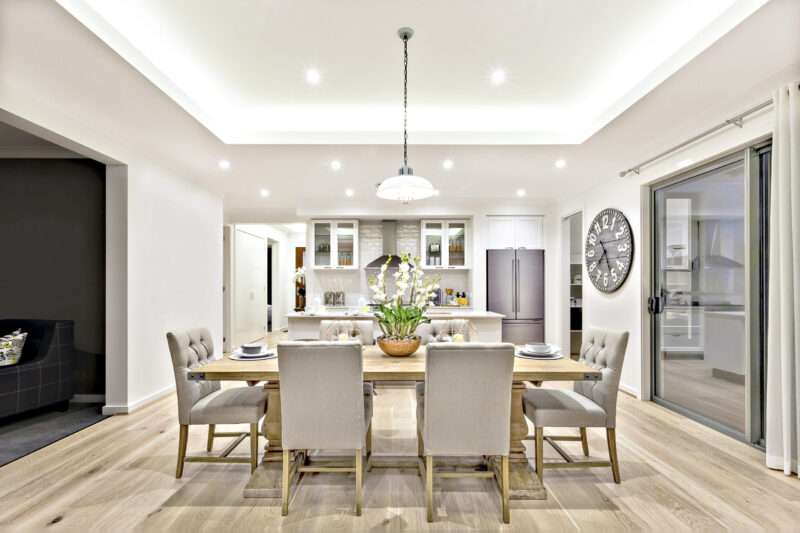When it comes to designing the perfect dining room, as well as considering aesthetics, it is important to consider lighting too.
During the design process, you’ll need to think about what you’ll use your dining room for – whether you’ll be hosting dinner parties with friends or enjoying weekly meals with your family, the right lighting can set the mood to make your dining room feel inviting, cosy, and usable for every occasion.
Dining room lighting ideas – how to get it right
As the summer season quickly approaches, creating the perfect hosting space is crucial. To help you with this, we’ve rounded up some expert tips and tricks for designing dining room lighting like a pro:
Consider the scale of your dining table light
Before you start investing in lighting for your dining room, it’s important to consider the size and scale of your room, along with its contents. Obviously, a smaller dining room will require fewer lights, while a larger dining room will require more. However, there are still a few general rules you should abide by.
Experts suggest for a long linear table, an elongated light fixture should be used instead of a single pendant light, as it will leave the outer sides of the table dark and unlit. Instead, a linear fixture will distribute the light evenly across the table and provide adequate lighting and vision for people when they are seated.
Some fixture options that fit perfectly with this style are our Spa Patras 4 Light Flush Light Bar ceiling light range, which can create track lighting above your dining room table. Alternatively, if you prefer a more asymmetrical look, our Spa Veria 5 Light Flush Ceiling Light could also be a great option.
For those with round or square dining tables, a central chandelier dining table light would work well, as they create focused light within a small space, and will make a statement feature whilst providing optimal lighting.
Create a focal point
In a dining room, the light fixture is often the focal point that draws people in. Choosing a fixture that complements the style of your dining room whilst also making a statement is an ideal way to achieve this.
A chandelier is a classic choice and adds an element of grandeur and class to any room. However, there are plenty of other options to choose from, including pendant lights, flush-mount fixtures, and sconces.
Pendant lighting is often used as dining room lighting, as this fixture, when grouped together in threes, creates a visually appealing appearance. Particularly in dining rooms with rectangular tables, a trio of pendant lights will help to define each part of the table and define your dining room space.
Layer your lighting
To create a warm and inviting atmosphere, it’s important to layer your lighting as well. This means using a combination of overhead lighting, accent lighting, and task lighting.
Whilst overhead lighting provides general illumination, accent lighting can highlight artwork or architectural details. On the other hand, task lighting would be ideal for reading or working.
For accent lighting, why not consider picture lighting which can help to highlight family pictures, artwork, or extra storage space in your dining room. As well as this, table lamps can create optimum task lighting and can be fully customised to match the wider aesthetic of your dining room by using different lamp shade colours and textures.
Consider the height of your dining table lighting
If you have high ceilings, low-hanging over-table lighting would be ideal to create a cocooned, intimate atmosphere amongst guests. A chandelier or a cluster of pendant lights hanging at different heights is a great way to achieve this look whilst also incorporating a dramatic design piece into your room.
When it comes to ceiling lights for low ceilings, a flush-mount fixture or semi-flush mount fixture is a better choice as it won’t overcrowd your room.
Choose the right bulbs
The type of bulbs you choose can also make a big difference to the look and feel of your dining room. Nowadays, LED bulbs are a much more energy-efficient and long-lasting alternative to incandescent bulbs that still allow you to create a bright, functional room.
Though dining room lighting can be used to support many daily activities, it is primarily used to create a cosy and inviting atmosphere for guests. Because of this, the colour temperature of your dining room light bulbs is extremely important. Where cooler colour temperatures are ideal for task lighting, warmer temperatures are better for creating an inviting atmosphere that so many of us desire.
To create ambient lighting a simple warm light LED light bulb will suffice. However, if you require dining room lighting throughout the day to assist you with different tasks, a dimmable LED light bulb will work much better and allow you to transition between bright and warm lighting whenever the need occurs.
Use dimmer switches
Finally, consider installing dimmer switches. Dimmer switches will give you more control over the lighting in your dining room by allowing you to adjust the brightness of the lights. This will provide you with versatile dining room lighting and allow you to achieve a multifunctional room.
Depending on the occasion, dimmer switches can create a bright and light room perfect for activities and family meals during the day but can quickly transition your dining room, allowing its relaxing, subtle glow to create a cosy and inviting atmosphere on an evening.
How to choose the perfect lighting for your dining room?
Lighting is an important factor to consider when designing your dining room. By choosing the right light fixtures, layering your lighting, and selecting the right bulbs, you can create a warm and inviting atmosphere that will make your dining room a space you’ll love to spend time in.
Go ahead and explore our full range of indoor lighting.
